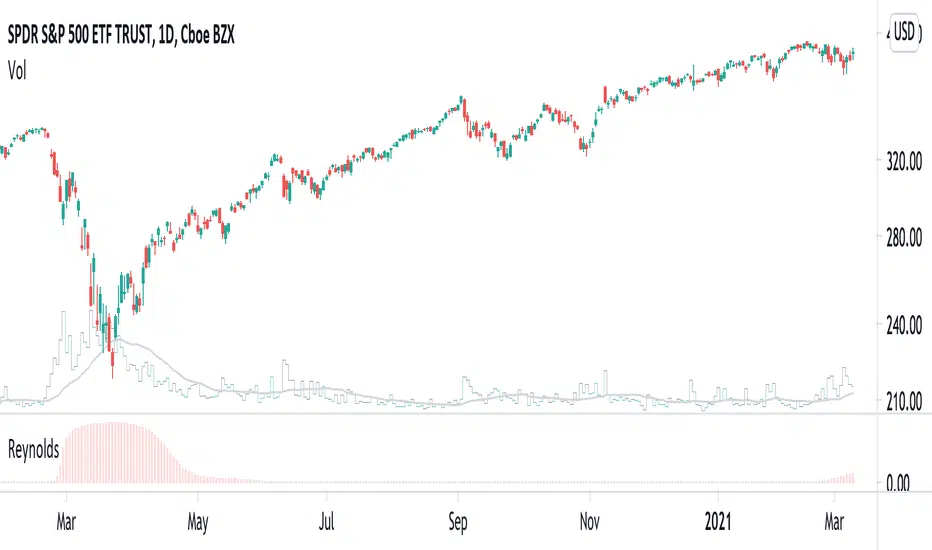OPEN-SOURCE SCRIPT
Reynolds warning rate

In fluid mechanics, the Reynolds number is the ratio of inertial forces to viscous forces within a fluid. Laminar flow occurs at low Reynolds numbers (i.e., viscous forces are dominant), whereas turbulent flow occurs at high Reynolds numbers (i.e., inertial forces are dominant). In the Turbulence indicator, I define that laminar flow occurs when simple moving averages have no interactions. In contrast, turbulent flow occurs when simple moving averages have chaotic interactions (i.e., irregular crossing and convergence).
Here, I calculate an economical analog of the Reynolds number developed by Jakimowicz and Juzwiszyn (2015). Furthermore, I propose the Reynolds Warning Rate, given by a ratio of short- and long-term Reynolds number.
The higher Reynolds Warning Rate indicates that price movement is going to a turbulence phase, and the market is under a possible systemic risk.
Reference:
Jakimowicz A, Juzwiszyn J (2015) Balance in the turbulent world of economy. Acta Physica Polonica A 127, 78–85.
Here, I calculate an economical analog of the Reynolds number developed by Jakimowicz and Juzwiszyn (2015). Furthermore, I propose the Reynolds Warning Rate, given by a ratio of short- and long-term Reynolds number.
The higher Reynolds Warning Rate indicates that price movement is going to a turbulence phase, and the market is under a possible systemic risk.
Reference:
Jakimowicz A, Juzwiszyn J (2015) Balance in the turbulent world of economy. Acta Physica Polonica A 127, 78–85.
สคริปต์โอเพนซอร์ซ
ด้วยเจตนารมณ์หลักของ TradingView ผู้สร้างสคริปต์นี้ได้ทำให้มันเป็นโอเพ่นซอร์ส เพื่อให้เทรดเดอร์สามารถตรวจสอบและยืนยันการทำงานของสคริปต์ได้ ขอแสดงความชื่นชมผู้เขียน! แม้ว่าคุณจะสามารถใช้งานได้ฟรี แต่อย่าลืมว่าการเผยแพร่โค้ดซ้ำนั้นจะต้องเป็นไปตามกฎระเบียบการใช้งานของเรา
คำจำกัดสิทธิ์ความรับผิดชอบ
ข้อมูลและบทความไม่ได้มีวัตถุประสงค์เพื่อก่อให้เกิดกิจกรรมทางการเงิน, การลงทุน, การซื้อขาย, ข้อเสนอแนะ หรือคำแนะนำประเภทอื่น ๆ ที่ให้หรือรับรองโดย TradingView อ่านเพิ่มเติมที่ ข้อกำหนดการใช้งาน
สคริปต์โอเพนซอร์ซ
ด้วยเจตนารมณ์หลักของ TradingView ผู้สร้างสคริปต์นี้ได้ทำให้มันเป็นโอเพ่นซอร์ส เพื่อให้เทรดเดอร์สามารถตรวจสอบและยืนยันการทำงานของสคริปต์ได้ ขอแสดงความชื่นชมผู้เขียน! แม้ว่าคุณจะสามารถใช้งานได้ฟรี แต่อย่าลืมว่าการเผยแพร่โค้ดซ้ำนั้นจะต้องเป็นไปตามกฎระเบียบการใช้งานของเรา
คำจำกัดสิทธิ์ความรับผิดชอบ
ข้อมูลและบทความไม่ได้มีวัตถุประสงค์เพื่อก่อให้เกิดกิจกรรมทางการเงิน, การลงทุน, การซื้อขาย, ข้อเสนอแนะ หรือคำแนะนำประเภทอื่น ๆ ที่ให้หรือรับรองโดย TradingView อ่านเพิ่มเติมที่ ข้อกำหนดการใช้งาน